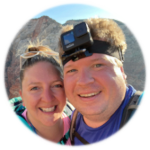Got your camper?! GREAT! Now you’re ready for your first trip! Right? Maybe not. When we bought our camper in March 2017, we were surprised by how little we knew (the worst part is that we had no idea how little we knew). You don’t know what you don’t know, amiright? But have no fear! We’re here to help you have a fun (and prepared) first trip. Here are five things you need before your first trip.
1. Wheel Chocks
Seems obvious, right? Looking back, this is the most obvious piece of equipment you need before your first trip. But when we bought our travel trailer, we had no idea what we were doing! In fact, we didn’t get wheel chocks until our third camping trip! Your stabilization jacks may support your camper on a flat surface, but you won’t be so lucky if there’s even the slightest incline. Trust us – we learned this lesson the hard way! As soon as we unhitched at Peak One Campground in Frisco, Colorado, the camper started to roll away! Ryan held on for dear life while I rushed to put the jacks down, hoping to stabilize the camper. We were able to stabilize it, but our stabilization jacks paid the ultimate price. Click here to check out our new stabilization jacks – they are significantly stronger than the ones that came with the trailer. But they still shouldn’t be used to prevent your camper from rolling away….
2. Sewage Line + Accessories
The sewage line is the least glamorous accessory you need, but it also makes you the most comfortable! You will need a sewer line to empty your grey (soapy water) and black (human waste) tanks after (or during) a camping trip. Luckily, these accessories aren’t expensive! First, you need a sewer hose. We purchased our first one from the dealership, but our second one from Amazon (after the first one went flying through Nebraska on I-80… whoops). Most campers will have space in the back bumper for the actual hose. (You might also want a magnetic bumper cap, to prevent the hose from taking flight mid-trip). You will also need a sewer elbow, a plastic piece that attaches the end of the sewer hose to the drain. It’s typically clear so you can see everything coming through! 🙂 You would be fine purchasing a set, like we have linked above. Finally, you will notice some people have a sewer line support. We don’t use one, but it could come in handy! Oh, and don’t forget disposable gloves and hand sanitizer to make the emptying task less … gross.
If you want to fill your fresh water tank – or hook up to a city water line – you’ll need a drinking water hose. Do not buy a garden hose from Home Depot. You need a hose that is safe to supply your drinking water. Luckily, these hoses are not expensive. We found ours on Amazon. We also use a water purifier. Note, however, that these purifiers can decrease your water pressure over time. This typically occurs because the filter gets dirty and the dirt blocks the flow of water. Pro tip: If you are camping in the extreme cold (below freezing), unhook the hose from the city water source overnight! This will prevent the hose or filter from freezing to the water spout – another lesson we learned the hard way!
Levelling blocks allow you level your camper without adding excess stress to your stabilization jacks. They are particularly important if your campsite is on a hill or other uneven surface. You can buy these fancy levelling blocks, but you don’t have to. We bought a few 2x4s from Home Depot and cut them into 1 foot pieces. These blocks allow you pile several under the jacks that need a little extra support. [Note: We always put at least one under each stabilization jack.] We keep the levelling blocks in a plastic tub when they are not in use. Pro tip: Don’t rest the tongue of the RV on a cored cement block. The weight of the camper can compromise and collapse the cement. Use wood blocks instead.
5. Electric Dogbones (50 AMP/15 AMP)
If you are headed to a campground with electrical hookups, make sure you have the correct equipment! Check before you go to determine what type of electrical hookup the campground offers. Our camper is equipped with a 30 AMP plug. Some campgrounds, however, offer only 15 or 50 AMP hookups. If you want to plug your camper into a traditional outlet (at your home, for example), you will need a 15 AMP dogbone, you can also buy a small adapter to save space (this is what we use now). Some campsite support only 50 AMP hookups, in which case, you will need a 50 AMP dogbone. We keep both in our passthroughs.
